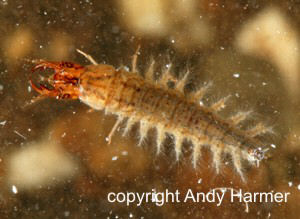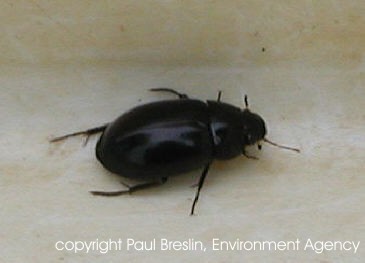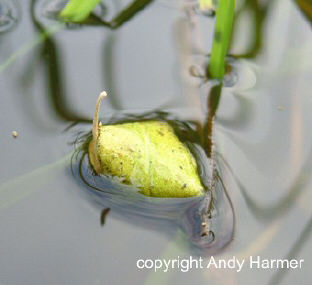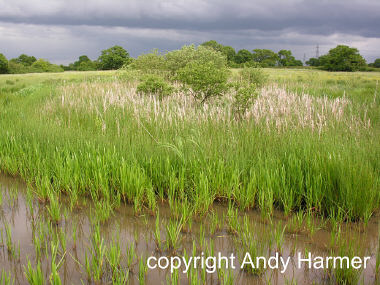LESSER SILVER WATER
BEETLE (HYDROCHARA CARABOIDES)
LOCAL BIODIVERSITY ACTION PLAN
Links
to associated HAPs and SAPs
Ponds,
Coastal and Floodplain grazing
marsh, Great Crested Newt
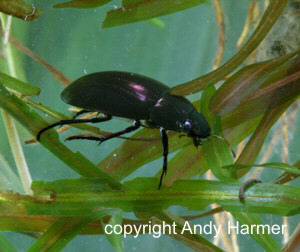 Current
Status
Current
Status
The lesser silver
water beetle is known to be present at several localities in the Cheshire region.
Since the discovery of an adult in a Cheshire pond in 1990, nine known breeding
ponds have been identified. It is considered that these may be the only known
breeding sites of this species outside the Somerset Levels (Kirby, 1994). Habitat
preferences include ditches, ponds and small standing water bodies (Kirby, 1994).
The lesser silver
water beetle is listed as Endangered in the Red Data Book of Insects (Shirt
1987). The beetle is included in Schedule 5 of the Wildlife and Countryside
Act (1981) and included on the middle list of the Biodiversity: The UK Steering
Group Report. A national Biodiversity Action Plan is included in the UK Biodiversity
Group Tranche 2 Action Plans Volume IV - invertebrates (1999).
Threats
- Disturbance to habitat, e.g. inappropriate
pond clearance.
- Habitat degradation, e.g. eutrophication
due to agricultural runoff.
- Infilling of ponds.
- Introduction of fish to ponds.
- Inappropriate development. For
example, it has been reported that a new owner at Brookhouse Farm has replaced
cattle with sheep and put in new drainage. These measures could adversely
affect the suitability of the pond for Hydrochara.
How are
we helping to conserve the Lesser Silver Water Beetle in the Cheshire region?
- Continued monitoring of existing
sites.
- Records held by rECOrd.
Objectives,
Targets and Actions
OBJECTIVES
|
NATIONAL
TARGETS
|
|
To determine
the range and size of the population and to promote and practice relevant
habitat management
|
Maintain viable populations
within the Somerset Moors and the Cheshire Plain. |
ACTIONS
REQUIRED
|
-
Form
a Local BAP Action Group for the lesser silver water beetle (Hydrochara
caraboides).
-
-
Establish
presence and range.
-
Pass
information gathered during survey and monitoring of this species
to record for the incorporation into national and international databases.
-
Research
into the ecological and habitat requirements of the species with particular
emphasis on the limiting factors associated with breeding.
-
Increase
awareness of the importance of this species.
-
Promote
appropriate pond management, minimise disturbance to habitat, maintain
and encourage marginal and host-specific vegetation.
-
Create
new ponds in areas of suitable habitat.
-
Raise
awareness of the ecological implications of collecting.
-
Hold
training event for surveyors.
-
Address
the requirements of this species in the LEAP process and in relevant
Water Level Management Plans.
-
Consider
the notification of sites holding key populations as SSSIs, where
this is necessary to secure their long-term protection and appropriate
management.
-
Ensure
that the habitat requirements of Hyrochara caraboides are taken
into account in any relevant development polices, plans and proposals.
-
Establish
a regular monitoring program.
-
Where
possible, ensure that all occupied habitat is appropriately managed.
This may be through SSSI or agri-environment scheme management agreements.
-
Advise
landowners and managers of the presence of this species and the importance
of beneficial management for its conservation.
-
Ensure
that all relevant agri-environment project officers, and members of
regional agri-environment consultation groups are advised of locations
of this species, its importance, and the management needed for its
conservation.
|
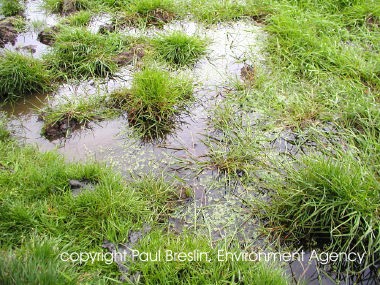 |
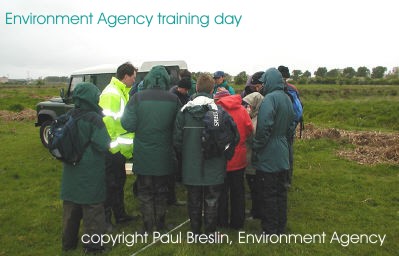 |
Progress
so far
| 2005
Action Completed |
-
BASC
reported multiple sites, found via their membership, for an ecologist
to survey for this species. They also found breeding evidence for
Great Crested Newts at 3
of these sites.
-
An
Environment Agency funded survey by Andy Harmer of likely ponds resulted
in twenty being surveyed. Of these, eleven showed evidence of the
beetle. Ten ponds had breeding evidence (cocoons or larvae). This
brings the number of known breeding ponds up to 34.
-
A
leaflet is being designed for the public and farmers alike, hopefully
to be launched next spring.
-
A
Hydrochara caraboides training day is being arranged for
next spring.
-
A
display regarding the 'Cheshire HC' was taken down to the Royal Entomological
Society (coleoptera day) in London and it was received well.
|
| 1997
- 2005 Action Completed |
-
Pond
Life Survey completed.
-
Survey
of the lesser silver water beetle Hyrochara caraboides in Cheshire
completed by Jonathan Guest EN (1996).
-
Targeted
pond management works for this species undertaken at Brookhouse Farm.
-
Survey
undertaken in Summer 2002 on behalf of Babtie/Mowlem of a pond to
be lost to the A500 Shavington - Hough Bypass. No larvae or adults
found. New ponds created.
-
LSWB
breeding pond retained as part of housing development in the Crewe
and Nantwich area.
-
Environment
Agency training day held
|
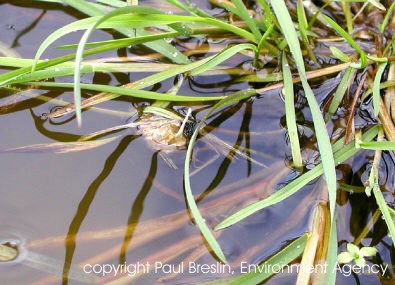 |
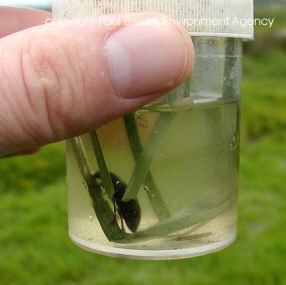 |
How to find
out more about the Lesser Silver Water Beetle
UK
BAP for the Lesser Silver Water Beetle - www.ukbap.org.uk/UKPlans.aspx?ID=377
Natural England Guidance Notes for Developers - www.english-nature.org.uk/About/teams/team_photo/GuidanceNotesforHydrochara5Sepdraft1.pdf
BugLife Action for Invertebrates - www.buglife.org.uk/html/project_action.htm
BugLife Guide to Wildlife Law and Invertebrates - www.buglife.org.uk/html/wildlife-law/conserving_wildlife_law10.htm
Contact
details
|
LBAP Chair |
Andy
Harmer
Phone: 01928 735847 |
| National
Lead Partner |
Balfour Browne
Club |
| National
Lead Contact |
Garth
Foster, Balfour Browne Club
Phone: 01292 525294 |
References
& Glossary
Foster, G.N. &
Eyre, M.D. (1992): Classification and Ranking of Water Beetle Communities, Joint
Nature Conservation Committee.
Guest J and Bentley DP (1995-8) Pond Life Project Critical Biodiversity
Survey, Pond Life Project, Liverpool John Moores University, Liverpool.
Guest, J. (1997): English Nature Research Report No. 248: 1996 Survey of the
lesser silver water beetle (Hydrochara caraboides) in Cheshire, English
Nature.
HMSO (1995): Biodiversity: The UK Steering Group Report, Volume 1: Meeting the
Rio Challenge, London.
HMSO (1995): Biodiversity: The UK Steering Group Report, Volume 2:Action Plans,
London.
Hyman, P. & Parsons, M. (1994): A Review of the Scarce and Threatened Coleoptera
of Great Britain, Part 1 UK Nature Conservation:3, Joint Nature Conservation
Committee.
Kirby, P. (1992): Habitat Management for Invertebrates: A Practical Handbook,
Royal Society for the Protection of Birds.
Liverpool Museum - Recorder information.
Kirby, P. (1994): Habitat Fragmentation: species at risk. Invertebrate group
identification. English Nature Research Report No. 89, Peterborough.
Parsons, M. (1987): Invertebrate Site Register: Review of Invertebrate Sites
in England: Cheshire, Report no. 95, part 1&2. Nature Conservancy Council.
Shirt, D.B. (Ed.) (1987): British Red Data Books: 2. Insects. Nature Conservancy
Council.
English Nature (1999). UK Biodiversity Group Tranche 2 Action Plans Volume IV
- invertebrates.
D C Boyce. A study of the distribution and ecology
of the lesser silver water beetle Hydrochara caraboides on the Somerset
Levels. English Nature Report No. 591


 Current
Status
Current
Status 